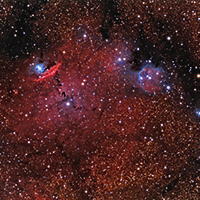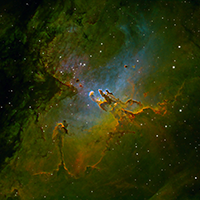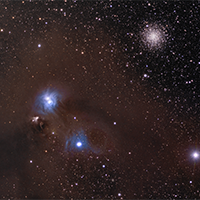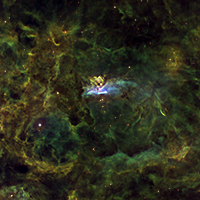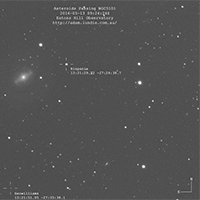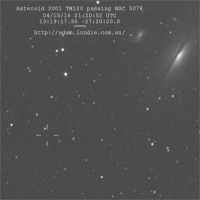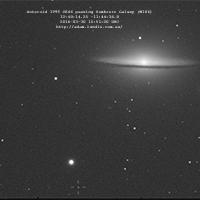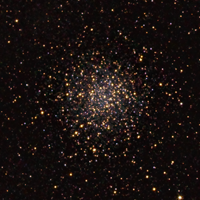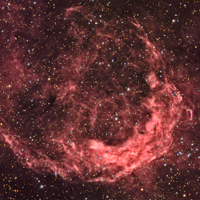Tagged: NGC
09-Aug-2016
Next to the Lagoon Nebula, there lies the often overlooked collection of absorption, reflection and emission nebulae: NGC 6559, IC 1274, IC 1275, IC 4684, IC 4685, Barnard 303, LDN 227, LDN 213, and planetary nebula PN M 1-41.
05-Jul-2016
The Eagle Nebula is located 7000 light years away and is home to the famous "Pillars of Creation", shown in the centre of this image. This photograph is presented in the Hubble narrowband palette, which shows the distrubution of Hydrogen (green), Oxygen (blue), and Sulfur (red) gasses.
26-Jun-2016
Less than 500 light-years away and blocking light from more distant, background stars in the Milky Way, the densest part of the dust cloud of Caldwell 68 is about 8 light-years long. At its tip is a group of reflection nebulae cataloged as NGC 6726, 6727, 6729, and IC 4812. A characteristic blue color is produced as light from hot stars is reflected by the cosmic dust.
07-Jun-2016
NGC 6357 is a diffuse nebula in the constellation Scorpius. The nebula contains many proto-stars shielded by dark disks of gas, and young stars wrapped in expanding gases. It is also known as the Lobster Nebula. Presented is a narrowband SHO photograph in the Hubble Space Telescope palette.
31-May-2016
This two panel mosaic shows the large galaxies NGC5101 (left) and NGC5078 (right), approximately 89 and 94 million light years distant. Galaxy IC879 is interacting with NGC5078, while galaxy IC4222 is shown in the bottom right corner. Numerous other small galaxies appear throughout the background
31-May-2016
This two panel mosaic shows the large galaxies NGC5101 (left) and NGC5078 (right), approximately 89 and 94 million light years distant. Galaxy IC879 is interacting with NGC5078, while galaxy IC4222 is shown in the bottom right corner. Numerous other small galaxies appear throughout the background
19-May-2016
Hispania (1915 WT) is the brightest asteroid I've ever seen. It's so bright, I had to remove it from each frame for plate solving to work. Also moving through the frame is another named asteroid: Geowilliams (1984 UL2)
19-Apr-2016
While looking through the data captured of NGC 5078, I discovered a very dim object slowly moving through the field of view. I have identified the object as main belt asteroid 2001 TM120, magnitude 15.5.
06-Apr-2016
The Antennae Galaxies, also known as NGC 4038/NGC 4039, are a pair of interacting galaxies ~45 million light years away. They are currently going through a starburst phase, in which the collision of clouds of gas and dust, with entangled magnetic fields, causes rapid star formation.
06-Apr-2016
The Antennae Galaxies, also known as NGC 4038/NGC 4039, are a pair of interacting galaxies ~45 million light years away. They are currently going through a starburst phase, in which the collision of clouds of gas and dust, with entangled magnetic fields, causes rapid star formation.
05-Apr-2016
While looking through the data captured of the Antennae galaxies, I discovered a very dim object slowly moving through the field of view. I have identified the object as main belt asteroid 2000 JU23, magnitude 18.8
31-Mar-2016
While looking through the data captured of the Sombrero Galaxy, I discovered an object slowly moving through the field of view. I have identified the object as main belt asteroid 1999 CK46, magnitude 17.4.
29-Mar-2016
The Jewel Box, Kappa Crucis Cluster, NGC 4755, is an open cluster in the constellation Crux. This cluster is one of the youngest known, with an estimated age of 14 million years. It is located 6,440 light years from Earth, and contains around 100 stars.
06-Mar-2016
It's been cloudy. Very cloudy. I managed to get a short imaging session, so I had to choose a bright target. The globular cluster Caldwell 79 was in the right place at the right time.
It is located at a distance of 16,300 light years from the Sun and has an estimated 254,000 times the mass of the Sun. This cluster is about 10.24 billion years old.
13-Feb-2016
NGC 3199 is a hydrogen emission nebula, about 12,000 light-years away. The nebula is about 75 light-years across with a Wolf-Rayet star generating an intense stellar wind in the center of its ring.
